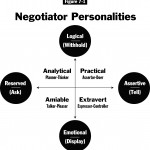During the 1990s, I enjoyed the good fortune to write and deliver more than a thousand public seminars on purchasing and negotiation. As a road warrior, I traveled five days a week for an average of 40 weeks per year. At least once a week, someone would ask a question about how to buy a car. Often, we would hold an on the spot exercise because others in the room wanted to hear the same thing. Considering that the seminar crowd was made up largely of professional buyers, how urgent must the need be for the ordinary vehicle buyer?
Just in casual conversation, the matter of how to buy cars arises frequently. The common refrain is that “I wish I knew how to buy a car. The sellers do it every day and I do it every few years.” In researching the market, I found that there were millions of online resources, mostly in the form of dealerships and other assorted sellers. There were also very many good resources with great advice on how to price and buy both new and used cars. One can find spread sheet templates, loan calculators, tips, and other helpful information. However, there was no one place that assembled useful information resources and a step by step how-to guide for the car buying public. The new online course, How to Buy a New or Used Car, will address this demand in the market.
My qualifications in this field include being a Certified Purchasing Professional (CPP) , Certified Professional Purchasing Consultant (CPPC) , and Certified Green Purchasing Professional (CGPP). Field credentials include having bought and leased scores of cars and trucks for employers and clients. Add the experience of buying many new and used vehicles for family members and having served auto dealers in consultant capacities earlier in my career and you may well ask, “What took you so long?”
The wait comes to an end in May of this year. The online course will be available on the American Purchasing Society. Here is what you will learn from this course.
Although this online course was written by a Certified Purchasing Professional, it is not aimed at the purchasing pro. Ironically, purchasing pros would benefit by this course since they are not routinely engaged in this personal pursuit. In a larger sense, this online course solves the request from the general public for a knowledgeable and workable solution to perhaps the most predominant purchasing problem in America – that of how to buy a car! We will explore, discuss, and solve the most problems involved with buying a new or used car such as
- What kind of vehicle should I buy
- Is new or used best for me
- How much should I pay for a new or used car
- What is the “true cost” of a new or used vehicle
- Should I buy or lease
- How do I manage the car salesman
- How do I manage the car dealer
- Where can I obtain the best financing
- How do I know if my trade-in price is realistic
- What is negotiable when buying a car
- Should I use a dealer, private party, or internet sources to buy a new or used car
- How do I finance the purchase
- What role does my credit profile play in the financing
- What information resources are best to consult
- What kind of things do I not know to avoid drastic mistakes
You will find practical advice along with personal anecdotes that punctuate the buying experience, and scores of pointers on what to do, what not to do, what to expect, and what you need to understand about the car buying world.



 Don’t waste your time
Don’t waste your time
 Sell your (Cost) strengths
Sell your (Cost) strengths 
 Applying the Model
Applying the Model
 401(k)’s are good deals for many reasons. First, the company match is free money. If the company is matching, say 5% of the employee’s salary, the employee in effect is receiving a 5% bonus; however, the employee must put in the 5% in order to receive the match. How cool is that? Secondly, the employee’s contribution is tax-deferred. This does NOT mean tax-free. What it means is that the employee will not pay federal income taxes on their contribution. So, if the employee makes $40,000 a year and contributes $5,000, their W-2 at the end of the year will reflect wages of only $35,000, thus saving taxes on the $5,000 contribution. When the employee retires, and withdraws the $5,000, the amount is taxed at that time. Presumably, at that time, the retired employee will be in a lower tax bracket than when they earned the money. Last, the amount in the 401(k) grows tax-deferred, so it can grow to a larger amount a lot faster, as Uncle Sam is not reaching in and taking his share of the employee’s growth.
401(k)’s are good deals for many reasons. First, the company match is free money. If the company is matching, say 5% of the employee’s salary, the employee in effect is receiving a 5% bonus; however, the employee must put in the 5% in order to receive the match. How cool is that? Secondly, the employee’s contribution is tax-deferred. This does NOT mean tax-free. What it means is that the employee will not pay federal income taxes on their contribution. So, if the employee makes $40,000 a year and contributes $5,000, their W-2 at the end of the year will reflect wages of only $35,000, thus saving taxes on the $5,000 contribution. When the employee retires, and withdraws the $5,000, the amount is taxed at that time. Presumably, at that time, the retired employee will be in a lower tax bracket than when they earned the money. Last, the amount in the 401(k) grows tax-deferred, so it can grow to a larger amount a lot faster, as Uncle Sam is not reaching in and taking his share of the employee’s growth. has taken the position that the average sales person, or drummer… has very limited authority…In short, the average sales person does not have the authority to enter into a contract with you.” In that ‘competent parties’ are one of the four essentials of a contract, were a buyer to engage in serious buy/sell negotiations with an unauthorized party, he or she would be setting up the seller to pull the justified ‘higher authority’ tactic so well know in auto sales show rooms.
has taken the position that the average sales person, or drummer… has very limited authority…In short, the average sales person does not have the authority to enter into a contract with you.” In that ‘competent parties’ are one of the four essentials of a contract, were a buyer to engage in serious buy/sell negotiations with an unauthorized party, he or she would be setting up the seller to pull the justified ‘higher authority’ tactic so well know in auto sales show rooms.
